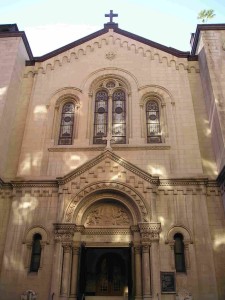
The well from which the San Gennaro Festival draws its zany carnival energy is surprisingly the church which sits its center, the birthplace of the first U.S. San Gennaro feast, at the Church of the Most Precious Blood, between Baxter and Mulberry in Little Italy.
The ‘Most Precious Blood’ in this case refers not only to Christ’s blood, but that of Gennaro, which, as I mentioned yesterday, has the uncanny ability to reliquify itself a couple times every year. This, despite being over 1,700 years old. This actually happens twice a year, like clockwork, on Sept 19, the feast day, as well as on the first Sunday in May, when Gennaro’s relics are formally moved in a procession between sacred locations in Naples, Italy.
The Church of the Most Precious Blood is of far humbler origins, tying its history to the huge influx of Italians immigrating to the United States. Although the peak of the Italian move wouldnt be reached until the 1920s, by the late 19th century there were enough Italians in the lower reaches of the Bowery that they soon began to outnumber the Irish already living there. As we spoke about in our podcast on Ole Saint Patricks (just a few blocks up from Most Precious Blood and abuts the San Gennaro Festival on its Mulberry side) Italians were forced to worship in the basements of pre-existing churchs.
As long as its existed, the Church of the Most Precious Blood has always been about money, or lack thereof. In 1888, the Vatican decreed that a parish be built specifically for the growing number of Italians. The Scalabrini Fathers tasked to construct it couldnt afford to finish it, so it passed to Franciscan Friars, who completed it in 1892.
The Church has always been a bit burdened financially. In fact, the proceeds of the religious souvenirs for purchase outside go to the parish. (The pic below is of the back of the church, which faces the festival.)
There used to be another lucrative fund-raising method during San Gennaro — gambling — which took place alongside the quaint, narrow garden. The city cracked down on this activity in the 90s when it was alledged that members of the notorious Genovese crime family were skimming some of the profits.
The current garden has as many religious statues growing as plants.
Okay, but why do I like it so much? In 1995 the interior was heavily renovated under the auspices of its leader Father Fabian Grifone. (Controversial cardinal John O’Connor called it a ‘precious jewel’.) What has essentially been done is that the original interior, a rather tasteful and solemn design with white limestone walls and murals above the altarpiece, has been crammed with multi-colored religious artifacts. Its chapels have been turned into glorious dioramas.
The back wall underneath the balcony is lined with a host of saints colorfully rendered and frozen in odd — some might say, disturbing — poses.
Along the left side of the main room sits the St Jude Shrine, ablaze with ‘leafs’ that parishoners can buy in memory of certain individuals. The leaves were entirely sold out, and I wonder if they’ll just keep down going alongside the wall.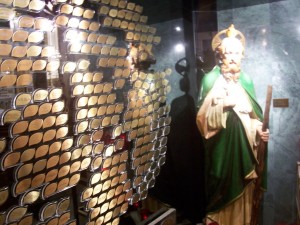
Alongside the right side stands this curious piece, which I believe to be a shrine to St. Pio. To me, he looks a bit like RoboCop.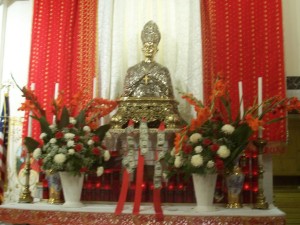
At back are two smaller rooms which contain the shrines to Gennaro and to Mary. In particular, Mary is kept within a wild set piece that would not be out of place in a fantasy film.
Mary shares the room with this curious painting.
In retrospect, the alterpiece seems a bit barren, the lovely murals surrounding it in bad need of cleaning.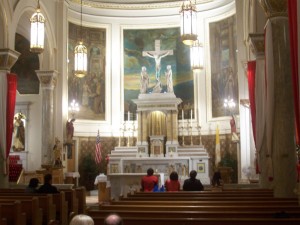
Most Precious Blood and the home of San Gennaro in the United States is by no means a classic standard of American church building, but it’s a heck of a lot of fun to walk throgh.

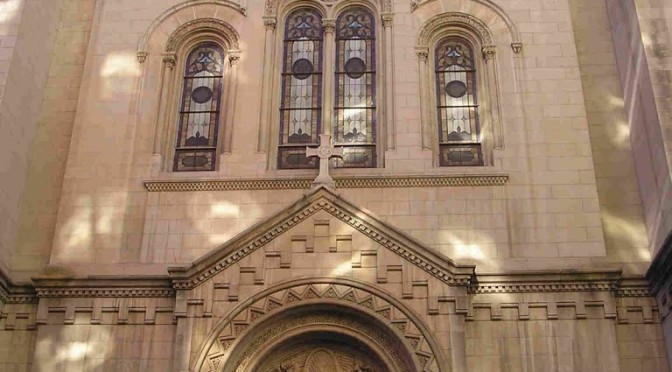
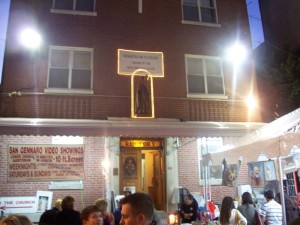
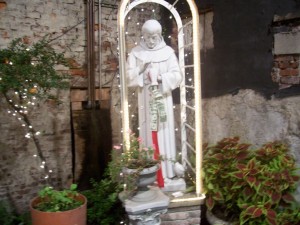
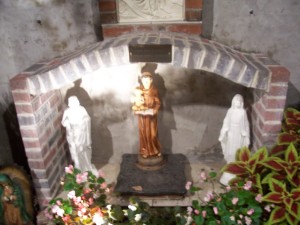
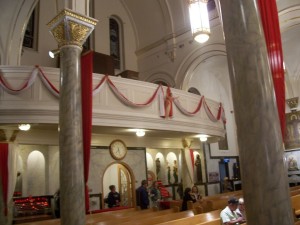
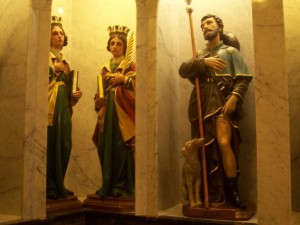
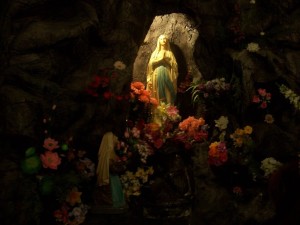
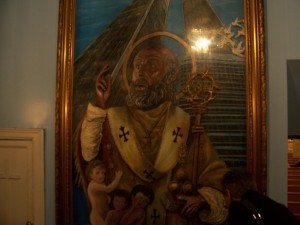
1 reply on “San Gennaro Festival (Part 2) : Most Precious Blood”
I am a former New Yorker that lived right on Mulberry Street. I attended St. Patricks and had my first communion and confirmation at Old St. Patrick Catherdal. I was looking for the next time the feast would be celebarate and found your site. I’m ashamed to say it but I didn’t know anything about the origins of the feast, I just enjoyed it. Great information, I’ll look for you on Facebook.